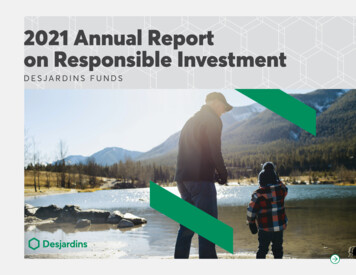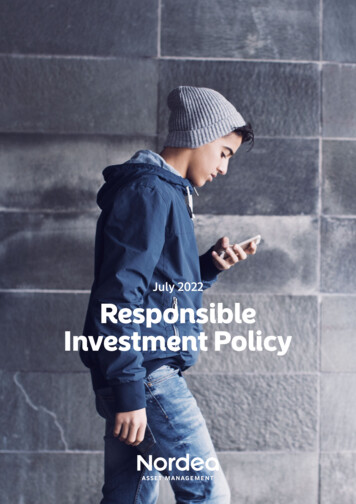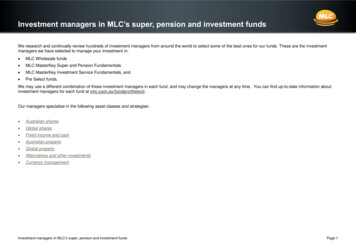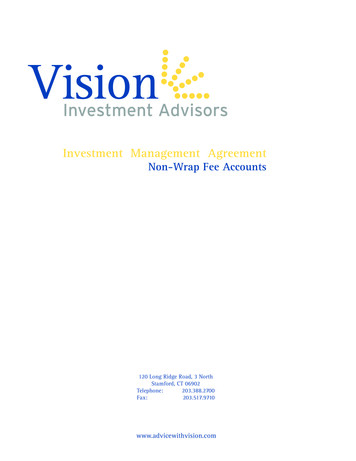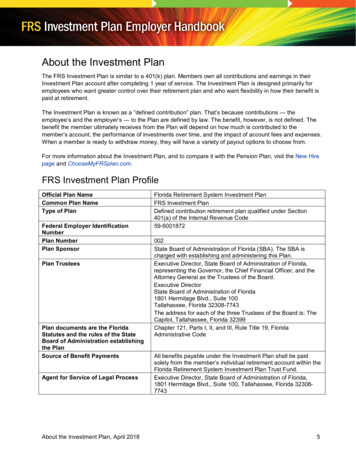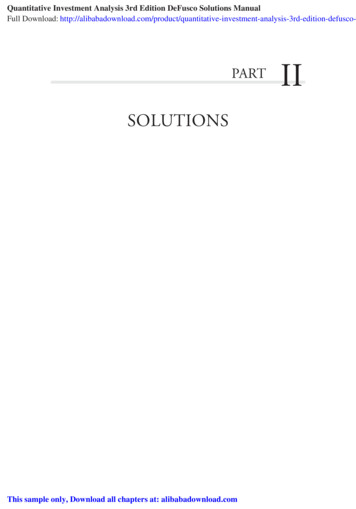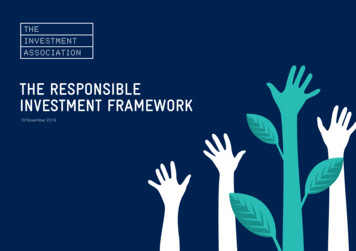
Transcription
THE RESPONSIBLEINVESTMENT FRAMEWORK18 November 2019
ABOUT THE IAThe Investment Association is the trade bodythat represents UK investment managers, whose 250 memberscollectively manage over 7.7 trillion on behalf of clients.Our purpose is to ensure investment managers are in the best possible position to: Build people’s resilience to financial adversity Help people achieve their financial aspirations Enable people to maintain a decent standard of living as they grow older Contribute to economic growth through the efficient allocation of capitalThe money our members manage is in a wide variety of investment vehiclesincluding authorised investment funds, pension funds and stocks & shares ISAs.The UK is the second largest investment management centre in the world andmanages 37% of European assets.Investment Association (IA) members hold in aggregate, one third of thevalue of UK publicly listed companies. We use this collective voice toinfluence company behaviour and hold businesses to account.More information can be viewed on our website.
THE RESPONSIBLE INVESTMENT FRAMEWORKIA RESPONSIBLE INVESTMENT FRAMEWORKNOTE:The components below are not mutually exclusive. They will typically be used in combination with one another.“Fund-level components” is a short-hand and can also refer to segregated mandates and individual investment strategies.FIRM-LEVEL COMPONENTSFUND-LEVEL COMPONENTSEXCLUSIONSSUSTAINABILITYFOCUSIMPACT INVESTINGEXAMPLES INCLUDE:EXAMPLES INCLUDE:EXAMPLES INCLUDE:EXAMPLES INCLUDE:PRI UES-BASED/RELIGIOUSSUSTAINABILITY THEMEDSOCIAL BOND FUNDSOVERSIGHT OF ASSETS ANDSERVICE PROVIDERSSTATEMENT OF COMMITMENTNORMSNORMSPOSITIVE TILTPRIVATE IMPACT INVESTINGENGAGING WITH ISSUERS ANDHOLDING THEM TO ACCOUNTFIRM-WIDE POLICIESSUSTAINABILITYBEST IN CLASSSDG FUNDSSTEWARDSHIPESG INTEGRATIONEXAMPLES INCLUDE:EXAMPLES INCLUDE:SETTING EXPECTATIONSEXERCISING RIGHTSAND RESPONSIBILITIES(E.G. VOTING)EXCLUSIONSPOOR SUSTAINABILITYESG ASSESSMENTESCALATING CONCERNSSTEWARDSHIPAPPROACH AND ACTIVITIES SPECIFIC TO INVESTMENT STRATEGYESG INTEGRATIONAPPROACH AND ACTIVITIES SPECIFIC TO INVESTMENT STRATEGY
THE RESPONSIBLE INVESTMENT FRAMEWORKGLOSSARYBelow is the glossary to accompany theResponsible Investment Framework.COMPONENT:ESG ition:The Investment Association adopts thedefinition of “ESG integration” according tothe UN PRI:The Investment Association adopts thedefinition of “Stewardship” according to TheUK Stewardship Code 2020 of the FinancialReporting Council.“The systematic and explicit inclusion ofmaterial ESG factors into investment analysisand investment decisions”4“Stewardship is the responsible allocation,management and oversight of capital to createlong-term value for clients and beneficiariesleading to sustainable benefits for theeconomy, the environment and society.”2Explanatory Note:ESG Integration alone does not prohibit anyinvestments. Such strategies could invest inany business, sector or geography as long asthe ESG risks of such investments are identifiedand taken into account.Firm LevelESG integration can be adopted as a firm-widepolicy and, in such instances, reflects a firm’scommitment to integrate ESG considerations,which will include both risk and opportunities.Fund LevelThe precise ways in which ESG considerationswill be taken into account in investmentanalysis and in the investment decision-makingprocess will differ in practice between differentinvestment funds, mandates and strategies.Therefore, the framework reflects ESGintegration undertaken at a firm level (typicallyarticulated by a firm-level policy) as well asthe practical application of ESG integration tospecific funds, mandates or strategies.Explanatory Note:Stewardship is shown on both a firm level and afund level to reflect that, whilst firms will adopttheir approach to Stewardship at a firm level,stewardship activities will differ across funds,asset classes and geographies. Global Sustainable Investment Alliance (GSIA) Equivalent: “Corporate Engagement and Shareholder Action: the use of shareholder power to influence corporate behaviour, including through direct corporateengagement (i.e., communicating with senior management and/or boards of companies), filing or co-filing shareholder proposals, and proxy voting that is guided by comprehensive ESG guidelines.“ -4cf4-814a-d14e156a1d87/Stewardship-Code Final2.pdf, p. 4. The Investment Association reserves the right to review its alignment with theFRC definition at any time.3 GSIA Equivalent: “ESG Integration: the systematic and explicit inclusion by investment managers of environmental, social and governance factors into financial analysis”4 /maindefinitionstoprireportingframework 127272.pdf p.5. The Investment Association reserves the right to review its alignment with the UK PRIdefinition at any time.12
THE RESPONSIBLE INVESTMENT xclusions prohibit certain investments froma firm, fund or portfolio. Exclusions may beapplied on a variety of issues, including to alignwith client expectations. They may be appliedat the level of: Sector Business activity, products or revenue stream A company; or Jurisdictions/countries.Examples: Investment approach that applies ethical/values-based/religious exclusions:Investment approach that excludesinvestments on the basis of ethical, valuesbased or religious criteria, for example,gambling, alcohol, or pork.56 Investment approach that applies normsbased exclusions6: Investment approach thatexcludes investments on the basis of notcomplying with international standards ofconduct, for example, the UN Human RightsDeclaration. Investment approach that applies exclusionson the basis of poor sustainability:Investment approach that excludesinvestments on the basis of sustainabilityconsiderations, for example, fossil fuelcompanies. Investment approach that applies exclusionson the basis of ESG assessment: Aninvestment approach that excludes the worstperforming companies relative to peers onthe basis of ESG assessment, for example, onthe basis of ESG ratings.Explanatory Note:Other terms used to refer to exclusions mayinclude “exclusionary approaches”, “negativescreens” and “screens”. Unlike the term“divestment”, which involves selling ownershipof something, exclusions refer to the strategyhaving not invested in something from the start.Exclusions determine that a fund or mandatedoes NOT invest in certain things. It does notconstitute an approach that is characterised byproactively allocating capital to specific assets.It may involve excluding investments from acertain sector or investments that derive aportion of their income from the sale of certainspecified products.Exclusions may be applied at both a firm and afund level.Firm LevelExclusions that apply across the entire firm/group.Fund LevelExclusions that are specific to a particularinvestment approach e.g. to a fund or are set bya client in a particular mandate. GSIA equivalent: Negative/exclusionary screening: the exclusion from a fund or portfolio of certain sectors, companies or practices based on specific ESG criteria GSIA Equivalent: Norms-based screening: screening of investments against minimum standards of business practice based on international norms
THE RESPONSIBLE INVESTMENT FRAMEWORKGLOSSARYCOMPONENT:Sustainability FocusDefinition:Investment approaches that select and includeinvestments on the basis of their fulfillingcertain sustainability criteria and/or deliveringon specific and measurable sustainabilityoutcome(s). Investments are chosen on thebasis of their economic activities (what theyproduce/what services they deliver) and ontheir business conduct (how they deliver theirproducts and services).Examples: Sustainability Themed Investing7: Aninvestment approach that specifiesinvestments on the basis of a sustainabilitytheme/themes. Examples might includeclimate change mitigation, pollutionprevention, sustainability solutions andapproaches that address one or more of theUN Sustainable Development Goals (SDGs).Explanatory Note:Adopting a Best in Class approach canmean having exposure to companies fromsectors that may not typically be considered“sustainable”. A Positive Tilt approach may alsomean this. A Positive Tilt is typified by havingless exposure to these kinds of companiesthan a traditional benchmark (e.g. FTSE 100,S&P 500). Best in Class8: An investment approachthat includes investments based on certainsustainability criteria to focus exposure onsector-leading companies. Best in Classapproaches can vary from selecting fromamongst the best performing companies(e.g. the lowest carbon / most energy efficientenergy producers) to excluding the worstperforming companies relative to peers. Positive Tilt: A portfolio that overweightsinvestments that fulfil certain sustainabilitycriteria and/or deliver on a specific andmeasurable sustainability outcome(s),relative to a benchmark (e.g. FTSE 100, S&P500), for example, half the carbon intensity ofthe benchmark.78 GSIA Equivalent: Sustainability themed investing: investment in themes or assets specifically related to sustainability (for example clean energy, green technology or sustainable agriculture) GSIA Equivalent: Positive/best-in-class screening: investment in sectors, companies or projects selected for positive ESG performance relative to industry peers
THE RESPONSIBLE INVESTMENT FRAMEWORKGLOSSARYCOMPONENT:Impact Investing9Definition:The Investment Association endorses theGlobal Impact Investing Network’s (GIIN)definition of Impact Investments: Private impact investing: Investing directlyin unlisted projects, companies or initiativesthat have the intention to generate positive,measurable social and environmental impactalongside a financial return, for example, oneor more of the Sustainable DevelopmentsGoals (an “SDG fund”).“Investments made with the intention togenerate positive, measurable social andenvironmental impact alongside a financialreturn.”10 SDG Impact Funds: Funds where impact ismeasured with respect to the UN SustainableDevelopment Goals (SDGs). This can beachieved, for example, through listed equities,a social bond fund or private impact investing.Examples:Explanatory Note:According to GIIN, “there are four key elements: Social bond fund: A fund that invests inbonds, whose funding is ring-fenced forprojects or initiatives that have the intentionto generate positive, measurable social andenvironmental impact alongside a financialreturn, for example, one or more of theSustainable Development Goals (an “SDGfund”).9Financial Returns: Impact investments seek afinancial return on capital that can range frombelow market rate to risk-adjusted market rate.This distinguishes them from philanthropy.Range of Asset Classes: Impact investmentscan be made across asset classes.Impact Measurement: A hallmark of impactinvesting is the commitment of the investorto measure and report the social andenvironmental performance of underlyinginvestments.”Intentionality: Impact investments intentionallycontribute to social and environmentalsolutions. This differentiates them from otherstrategies such as ESG investing, ResponsibleInvesting, and screening strategies. GSIA Equivalent: “Impact/Community Investing: targeted investments aimed at solving social or environmental problems, and including community investing, where capital is specifically directed totraditionally underserved individuals or communities, as well as financing that is provided to businesses with a clear social or environmental purpose” Global Impact Investing Network (GIIN), “What you need to know about impact investing” #what-is-impact-investing. The Investment Associationreserves the right to review its alignment with the GIIN definition at any time.10
The Investment AssociationCamomile Court, 23 Camomile Street, London, EC3A 7LLwww.TheIA.org@InvAssocNovember 2019 The Investment Association (2019). All rights reserved.No reproduction without permission of The Investment Association.
The UK is the second largest investment management centre in the world and manages 37% of European assets. Investment Association (IA) members hold in aggregate, one third of the value of UK publicly listed companies. We use this collective voice to influence company behaviour and hold businesses to account. More information can be viewed on our website. IA RESPONSIBLE INVESTMENT FRAMEWORK .



